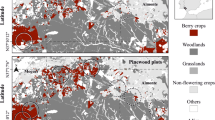Summary
Populations of Delphinium nelsonii have been shown to be patchy with regard to standing crop of nectar available to pollinators (Pleasants and Zimmerman 1979). Plants with relatively large amounts of nectar (“hot plants”) are associated with other hot plants while plants with relatively small amounts of nectar (“cold plants”) are found near other cold plants. Two possible explantations for this pattern exist: 1. Plants in close proximity to one another may have similar nectar production rates or; 2. The patterns of foraging bumblebees might create the observed nectar distribution pattern. By sampling standing crop of nectar in a D. nelsonii population during periods of both high and low bumblebee abundance evidence was gathered indicating that hot and cold spots are caused by bumblebees.
Similar content being viewed by others
References
Charnov EL (1976) Optimal foraging: The marginal value theorem. Theor Pop Biol 9:129–136
Charnov EL, Orians GH, Hyatt K (1976) Ecological implications of resource depression. Amer Natur 110:247–259
Heinrich B (1979) Resource heterogeneity and patterns of movement in foraging bumblebees. Oecologia (Berl) 140:235–245
Levin DA, Kerster NW (1969a) Density-dependent gene dispersal in Liatris. Amer Natur 103:61–74
Levin DA, Kerster NW (1969b) The dependence of bee mediated pollen and gene dispersal upon plant density. Evolution 23:560–571
Pleasants JM, Zimmerman M (1979) Patchiness in the dispersion of nectar resources: Evidence for hot and cold spots. Oecologia (Berl) 41:283–288
Price MV, Waser NM (1979) Pollen dispersal and optimal outcrossing in Delphinium nelsonii. Nature 277:294–297
Pyke GH (1978a) Optimal foraging in bumblebees and coevolution with their plants. Oecologia (Berl) 36:281–293
Pyke GH (1978b) Optimal foraging: Movement patterns of bumblebees between inflorescences. Theor Pop Biol 13:72–98
Schaal BA (1978) Density dependent foraging on Liatris pycnostachya. Evolution 32:452–454
Zimmerman M (1979a) An analysis of the reproductive strategies of Polemonium in Colorado. Ph D Thesis, Washington University, St. Louis
Zimmerman M (1979b) Optimal foraging: A case for random movement. Oecologia (Berl) 43:261–267
Zimmerman M (1981) Optimal foraging, plant density and the marginal value theorem. Oecologia (Berl) 49:148–153
Author information
Authors and Affiliations
Rights and permissions
About this article
Cite this article
Zimmerman, M. Patchiness in the dispersion of nectar resources: Probable causes. Oecologia 49, 154–157 (1981). https://doi.org/10.1007/BF00349182
Received:
Issue Date:
DOI: https://doi.org/10.1007/BF00349182




